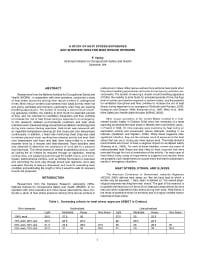Mining Publication: A Study of Heat Stress Exposures and Interventions for Mine Rescue Workers
Original creation date: February 2004
Authors: FD Varley
NIOSHTIC2 Number: 20026109
2004 SME Annual Meeting (Feb 23-25, 2004; Denver, CO), Preprint No. 04-107. Littleton, CO: Society for Mining, Metallurgy, and Exploration, Inc., 2004 Feb; :1-11
Researchers from the National Institute for Occupational Safety and Health (NIOSH), in cooperation with mine operators, conducted a study of heat stress exposures among mine rescue workers in underground mines. Mine rescue workers face extreme heat loads as they enter hot and poorly ventilated environments, particularly when they are wearing breathing apparatuses. The burden of wearing a closed-circuit breathing apparatus (CCBA), the inability to drink fluids for extended periods of time, and the potential for ventilation disruptions and fires combine to increase the risk of heat illness during a response to an emergency. In this research, ambient environmental conditions and heat strain indicators were measured using conventional ventilation monitoring tools during mine rescue training exercises. Heat strain was measured with an ingestible temperature-sensing pill that measured core temperature continuously. In addition, a heart-rate monitoring chest strap was used to indicate physical strain resulting from physical activity and heat. Both core temperature and heart rate data were transmitted to a remote recorder worn by a rescuer and time-stamped. Team activities were also observed to determine the contribution of work rate to a person's total heat load. The effectiveness of several engineering controls, such as cooling the air inhaled by rescuers through an apparatus, wearing cooling vests, and supplying water through the CCBA masks, were investigated. Administrative controls, such as limiting the duration of exposure and controlling the work rate through forced-rest regimens, were also evaluated. Results to date are discussed, and tools for evaluating team condition and estimating the length of time it would be safe for rescuers to work are proposed.

NIOSHTIC2 Number: 20026109
2004 SME Annual Meeting (Feb 23-25, 2004; Denver, CO), Preprint No. 04-107. Littleton, CO: Society for Mining, Metallurgy, and Exploration, Inc., 2004 Feb; :1-11
- Ergonomic Interventions at Unimin
- A General Framework for Prioritizing Research To Reduce Injuries and Diseases in Mining
- A Global Inventory of Mine Rescue Training Facilities: Compendium of Ideas to Improve U.S. Coal Mine Rescue Training
- Mine Rescue and Response
- Mine Rescue Training Facility Inventory - Compendium of Ideas to Improve US Coal Mine Rescue Training
- Mine Rescue Training Simulations and Technology
- New Simulated Gas Detector Offers Realistic Training for Mine Rescue Teams
- An Oral History Analysis of Mine Emergency Response
- An Overview of Technology and Training Simulations for Mine Rescue Teams
- Shiftwork: A Guide for Schedule Design